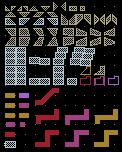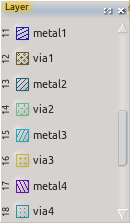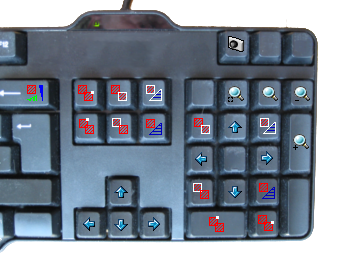
User Interface
The user interface of the LayoutEditor offers a outstanding usability as well as a high productivity. This is achieved by an extensive use of shortcuts and mouse buttons/keys combination together with clear visibility of this combinations. The most important handling functions like zooming and scrolling are integrated in each feature and need not to be called separately. Context menus are available for most parts of the user interface by a right mouse click. A three button wheel mouse is recommended for a effective use, but it is also possible to use any feature with a touch pad or one button mouse.
The user interface of the LayoutEditor is highly adjustable. The default appearance (shown on the right) only includes most important parts. Further tool bars, sub windows can be added on demand via the main menu or via a right click in the empty area of the menu bar/tool bar. A availability of some tool bars/sub windows depend on the LayoutEditor version you use.
The parts of the user interface are described next. It will start with the most important part of the user interface, the main drawing:
Drawing
 The major area of the user interface is used by the drawing. The design is displayed here. All graphical editing is done inside this part. But also any menu feature can be called from the drawing part. Ether by shortcut or the context menu. The mouse function depends on the activated mode. But three basic feature are always active:
The major area of the user interface is used by the drawing. The design is displayed here. All graphical editing is done inside this part. But also any menu feature can be called from the drawing part. Ether by shortcut or the context menu. The mouse function depends on the activated mode. But three basic feature are always active:
 The main menu and/or context menu is opened by a right click in the drawing.
The main menu and/or context menu is opened by a right click in the drawing.
 Hold the right mouse-button to scroll.
Hold the right mouse-button to scroll.
 Use the mouse-wheel to zoom in/out. You will get a fine zoom, if the mouse wheel is used together with the Shift key, and a very fine zoom with the Control key.
Use the mouse-wheel to zoom in/out. You will get a fine zoom, if the mouse wheel is used together with the Shift key, and a very fine zoom with the Control key.
Layer Button
 Via this buttons the display of the drawing is controlled. Visibility, color, fill-style, etc. is set via these buttons. All setup can (like any other function) also be done via the main menu or the context menu of this sub window. The appearance of the layer window can also be controlled via the setup. As block view or a list view is possible.
Via this buttons the display of the drawing is controlled. Visibility, color, fill-style, etc. is set via these buttons. All setup can (like any other function) also be done via the main menu or the context menu of this sub window. The appearance of the layer window can also be controlled via the setup. As block view or a list view is possible.
The most important mouse functions in the layer control are:
 left click to make layer active.
left click to make layer active.
 or
or  shift left/middle click to toggle visibility of a layer.
shift left/middle click to toggle visibility of a layer.
 shift+ctrl left click to edit layer properties.
shift+ctrl left click to edit layer properties.
 right click to show a context menu. Via the context menu you can also change to view of the layer window itself. For further setups, please use the SetupDialog.
right click to show a context menu. Via the context menu you can also change to view of the layer window itself. For further setups, please use the SetupDialog.
Mouse Help

 The mouse help sub window shows the occupancy of all mouse buttons. The window is display by default in the lower left of the user interface. If the sub window is closed, you can reopen it by a right click in an empty part of the tool bar or menu bar and activate Mouse Help in the list of available windows/tool bars..
The mouse help sub window shows the occupancy of all mouse buttons. The window is display by default in the lower left of the user interface. If the sub window is closed, you can reopen it by a right click in an empty part of the tool bar or menu bar and activate Mouse Help in the list of available windows/tool bars..
Following mouse buttons modifier combinations are used:
button: |
no |
left |
middle |
right |
|
key(s): |
|
|
|
|
|
shift |
|
|
|
|
|
control |
|
|
|
|
|
alt |
|
|
|
|
|
shift+control |
|
|
|
|
|
move mouse |
|
|
|
|
|
move mouse+shift |
|
|
|
|
|
move mouse+control |
|
|
|
|
|
move+shift+control |
|
|
|
|
|
hold mouse button |
|
|
|
|
Tool Buttons
 Most functions are available direct via a tool button. Help on the individual buttons is accessible through the "What's This" function (Shift+F1).The visibility of the different toolbars can adjusted via a right click on a free place in the dockarea. After program start the last setup is recovered.
Most functions are available direct via a tool button. Help on the individual buttons is accessible through the "What's This" function (Shift+F1).The visibility of the different toolbars can adjusted via a right click on a free place in the dockarea. After program start the last setup is recovered.
 Right mouse click to adjust toolbar setup.
Right mouse click to adjust toolbar setup.
Multitool Buttons
 Some Tool Buttons are Multitool Buttons. A subfunctions can be selected.
Some Tool Buttons are Multitool Buttons. A subfunctions can be selected.
 or
or  Shift left/middle click to select subfunction.
Shift left/middle click to select subfunction.
Position Indicator
 Shows the absolute coordinates with units. In some modes also relative coordinate are displayed in braces.
Shows the absolute coordinates with units. In some modes also relative coordinate are displayed in braces.
 opens a menu which allows changing the user units.
opens a menu which allows changing the user units.
Grid Indicator
 Shows the grid size. It is also displayed, if an adaptive grid mode is active (AUTO).
Shows the grid size. It is also displayed, if an adaptive grid mode is active (AUTO).
 opens a menu which allows changing grid settings.
opens a menu which allows changing grid settings.
Select Indicator
 Shows a statistic on selected elements.
Shows a statistic on selected elements.
 opens a menu which allows select/deselect.
opens a menu which allows select/deselect.
Time Indicator
 Shows some performance information on computing intensive operations like drawing time or DRC operation.
Shows some performance information on computing intensive operations like drawing time or DRC operation.
 opens a context menu which allows to adjust performance settings.
opens a context menu which allows to adjust performance settings.
Shortcuts
 Nearly all functions can also be accessed via shortcuts. The most important functions like select and zoom are mapped on number-block.
Nearly all functions can also be accessed via shortcuts. The most important functions like select and zoom are mapped on number-block.
A list of all shortkeys can be found here. With the "CapsLock" key you can display all available shortcuts on the associated tool buttons.
Versions
The LayoutEditor is extremely scalable. It can be used for very simple tasks as well as complex multi Gb designs. To achieve this it is avaiable in three versions:
Menus
Please find here an overview on the different menus in the LayoutEditor:









